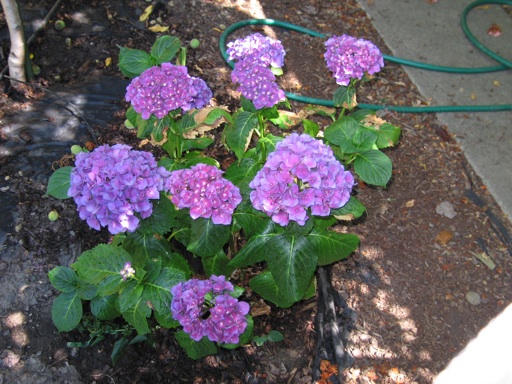Thinking of Bigleaf Hydrangeas
This time of year there’s not much fruiting or blooming in our yard. The few plants that are blooming are not exactly photogenic. So I included some photos of a few of the bigleaf/garden hydrangeas that were blooming in our yard last summer.
Hydrangeas must be one of the most beautiful of garden flowers. Their eye-catching mass of colorful flowers last for weeks in June and July before fading gradually, or more suddenly when a heat wave hits.
When the inevitable heat wave occurs our area in June or July, our bigleaf hydrangeas wilt badly. Every time it happens, I water them excessively to rejuvenate them, but they never fully recover their original beauty. Instead, the flowers and leaves get burnt edges that get larger with each additional hot spell, as shown in the above picture of one of our hydrangeas taken back on June 22. Even under typical weather conditions, hydrangeas need a lot more water than most of our garden plants.
But during hot weather (90s F), I have not been able to prevent them from wilting. I have transplanted most of our hydrangeas from partly shady locations into the few locations in our yard that receive shade nearly all day long. The hydrangeas growing in the shade still wilt in hot weather, but not as severely, even though they are being watered daily. I am coming to the conclusion that bigleaf hydrangeas are not ideally suited to our climate despite the fact that the average high temperature in the summertime here is only in the upper 70s F. Despite the wilting, I like hydrangeas so much that I keep them anyway.
One of the interesting things about hydrangeas is that the flowers never seem to fall off. The color just fades to gray or brown over a period of months. Even in December, our hydrangeas still have flowers on them, but they are unattractive looking. The two pictures below show one of our purple hydrangeas. I took the first picture on July 4, and I took the second picture today, December 14. It’s amazing that the flowers have managed to retain most of their shape after so long.
For me, winter gardening consists mainly of tasks to prepare for spring. One of the tasks I perform each winter is to cut off the stems of all of the bigleaf hydrangeas flowers that bloomed last summer. I have heard repeatedly from other gardeners that bigleaf hydrangeas must be pruned each winter to remove the old dead flowers, otherwise they won’t bloom next season. I haven’t put that idea to test yet to see if failing to prune really does prevent them from flowering. I figure that cutting off the old flowers is probably a good idea anyway just to make the plant look better and to stimulate new growth next season.
December 14 2008 02:35 pm | Hydrangeas


